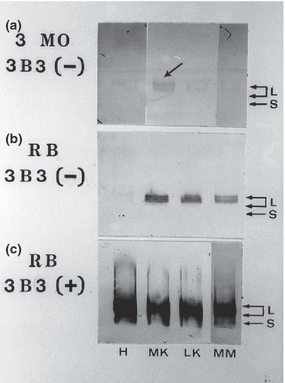Fell-Muir Lecture: chondroitin sulphate glycosaminoglycans: fun for some and confusion for others
- PMID: 22264297
- PMCID: PMC3311016
- DOI: 10.1111/j.1365-2613.2011.00807.x
Fell-Muir Lecture: chondroitin sulphate glycosaminoglycans: fun for some and confusion for others
Abstract
This review emphasizes the importance of glycobiology in nature and aims to highlight, simplify and summarize the multiple functions and structural complexities of the different oligosaccharide combinatorial domains that are found in chondroitin sulphate/dermatan sulphate (CS/DS) glycosaminoglycan (GAG) chains. For example, there are 1008 different pentasaccharide sequences possible within CS, DS or CS/DS hybrid GAG chains. These combinatorial possibilities provide numerous potential ligand-binding domains that are important for cell and extracellular matrix interactions as well as specific associations with cytokines, chemokines, morphogens and growth factors that regulate cellular differentiation and proliferation during tissue development, for example, morphogen gradient establishment. The review provides some details of the large and diverse number of different enzymes that are involved in CS/DS biosynthesis and attempts to explain how differences in their expression patterns in different cell types can lead to subtle but important differences in the GAG metabolism that influence cellular proliferation and differentiation in development as well as regeneration and repair in disease. Our laboratory was the first to generate and characterize monoclonal antibodies (mAb) that very specifically recognize different ‘native’ sulphation motif/epitopes in CS/DS GAG chains. These monoclonal antibodies have been used to identify very specific spatio-temporal expression patterns of CS/DS sulphation motifs that occur during tissue and organ development (in particular their association with stem/progenitor cell niches) and also their recapitulated expression in adult tissues with the onset of degenerative joint diseases. In summary, diversity in CS/DS sulphation motif expression is a very important necessity for animal life as we know it.
Figures






Similar articles
-
Recent advances in the structural study of functional chondroitin sulfate and dermatan sulfate in health and disease.Connect Tissue Res. 2008;49(3):133-9. doi: 10.1080/03008200802148546. Connect Tissue Res. 2008. PMID: 18661328 Review.
-
Identification of monoclonal antibodies that recognize novel epitopes in native chondroitin/dermatan sulfate glycosaminoglycan chains: their use in mapping functionally distinct domains of human skin.J Histochem Cytochem. 1990 Mar;38(3):393-402. doi: 10.1177/38.3.1689338. J Histochem Cytochem. 1990. PMID: 1689338
-
Interaction of chondroitin sulfate and dermatan sulfate from various biological sources with heparin-binding growth factors and cytokines.Glycoconj J. 2013 Aug;30(6):619-32. doi: 10.1007/s10719-012-9463-5. Epub 2012 Dec 29. Glycoconj J. 2013. PMID: 23275130
-
Functions of chondroitin sulfate/dermatan sulfate chains in brain development. Critical roles of E and iE disaccharide units recognized by a single chain antibody GD3G7.J Biol Chem. 2007 Jul 6;282(27):19442-52. doi: 10.1074/jbc.M700630200. Epub 2007 May 10. J Biol Chem. 2007. PMID: 17500059
-
The dual role of the glycosaminoglycan chondroitin-6-sulfate in the development, progression and metastasis of cancer.FEBS J. 2019 May;286(10):1815-1837. doi: 10.1111/febs.14748. Epub 2019 Feb 5. FEBS J. 2019. PMID: 30637950 Free PMC article. Review.
Cited by
-
Machine-Assisted Discovery of Chondroitinase ABC Complexes toward Sustained Neural Regeneration.Adv Healthc Mater. 2022 May;11(10):e2102101. doi: 10.1002/adhm.202102101. Epub 2022 Feb 21. Adv Healthc Mater. 2022. PMID: 35112508 Free PMC article.
-
Biochemical composition and turnover of the extracellular matrix of the normal and degenerate intervertebral disc.Eur Spine J. 2014 Jun;23 Suppl 3:S344-53. doi: 10.1007/s00586-013-2767-8. Epub 2013 Apr 17. Eur Spine J. 2014. PMID: 23591805 Review.
-
Aggrecan and chondroitin-6-sulfate abnormalities in schizophrenia and bipolar disorder: a postmortem study on the amygdala.Transl Psychiatry. 2015 Jan 20;5(1):e496. doi: 10.1038/tp.2014.128. Transl Psychiatry. 2015. PMID: 25603412 Free PMC article.
-
Chondroitin sulphate: a focus on osteoarthritis.Glycoconj J. 2016 Oct;33(5):693-705. doi: 10.1007/s10719-016-9665-3. Epub 2016 May 19. Glycoconj J. 2016. PMID: 27194526 Review.
-
Proteoglycan metabolism, cell death and Kashin-Beck disease.Glycoconj J. 2012 Aug;29(5-6):241-8. doi: 10.1007/s10719-012-9421-2. Epub 2012 Jun 26. Glycoconj J. 2012. PMID: 22733148 Free PMC article. Review.
References
-
- Carlson CS, Loeser RF, Johnstone B, Tulli HM, Dobson DB, Caterson B. Osteoarthritis om cynomolgus,acaques. II. Detection of modulated proteoglycan epitopes in cartilage and synovial fluid. J. Orthop. Res. 1995;13:399–409. - PubMed
-
- Carney SL, Billingham MEJ, Caterson B, et al. Changes in proteoglycan turnover in experimental canine osteoarthritic cartilage. Matrix. 1992;12:137–147. - PubMed
-
- Caterson B, Christner JE, Baker JR. Characterization of a monoclonal antibody that specifically recognizes Corneal and Skeletal Keratan Sulfate. J. Biol. Chem. 1983;258:8848–8854. - PubMed
Publication types
MeSH terms
Substances
Grants and funding
LinkOut - more resources
Full Text Sources
Other Literature Sources

